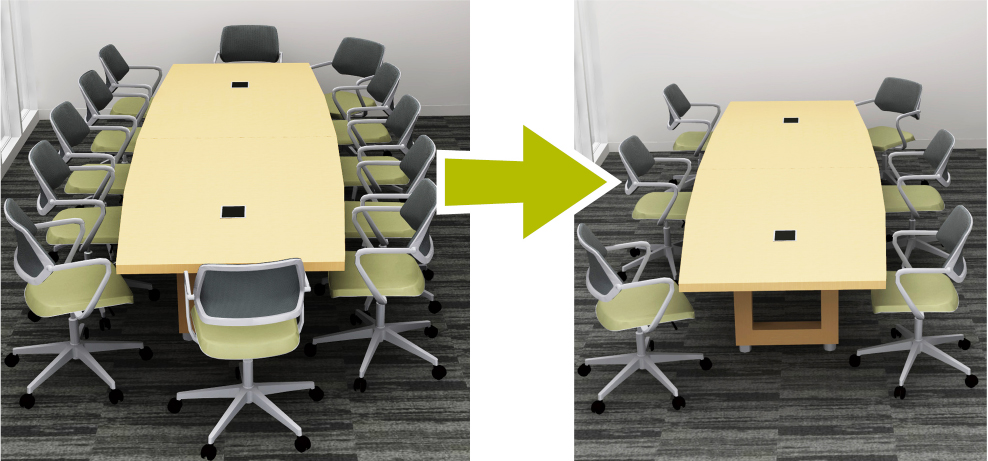In Your Space: Considerations in Lobby and Work Environment Configurations
The COVID-19 pandemic has forced nearly every business and bank to critically review and analyze current physical work environments, person-to-person interactions and processes in order to prevent the spread of this highly contagious virus. This has led to a wide array of layout rearrangements, from minor shifting or removal of furniture to major overhauls of space, with the goal of safely and practically accommodating employees and customers while maintaining “normal” business functions.
Ohio Desk, a commercial furniture wholesaler and space planning consultant, has graciously allowed us to share the following conceptual workspace configurations and considerations. The information below is provided only as thought starters. Please
refer to official government resources such as the CDC and OSHA COVID-19 guidelines and recommendations regarding modifications to lobbies and office areas.
Café Spaces
Physical Changes☑ Provide more circulation within a café area by increasing aisle widths
☑ Provide more individual settings within the space
☑ Provide adequate spacing within food and cashier lines, allowing users to keep a physical distance
☑ Restrict communal dining of groups
Policy Changes
☑ Stagger break / lunch times to limit quantity of people in the space
☑ Consider directional travel through space
☑ Addition of hand washing stations where wipes and hand sanitizers are readily accessible and fully supplied
☑ Limit interaction
with food supplies, possibly shifting from facilitated to self-serve only

Meeting & Shared Spaces
Physical Changes
☑ Provide distance between seats—reduce the number of chairs around a table
☑ Change expectation of room occupancy and post maximum capacity signs
☑ Consider designating enter and egress directions,
i.e. always moving clockwise in and out of the space
☑ In shared casual settings, remove sofas or loveseats from shared spaces, leaving only individual seats, spread 6 feet apart
Policy Changes
☑ Be strategic about each meeting—is it really a conversation that is necessary to have in person?
☑ Consider scheduling in-person meetings in shortened time windows (example: 50 minutes rather than 60 minutes)
to provide
the ability to clean the environment between sessions
☑ Consider “owned” meeting and collaboration spaces, possibly by a team or department, to decrease cross contamination
☑ Continue to support
and enhance virtual connections with those in the room and with those still working remotely
☑ Implement protocols to limit meeting sizes

Open Office Work Area
Physical Changes
☑ Remove existing workstations or task chairs to ensure that users do not sit too close to each other and to maintain recommended distance between individuals
☑ Reduce the number of workers in a cluster or row
☑ Reconfigure workstations so that users are back-to-back versus shoulder-to-shoulder or face-to-face
☑ Add handwashing stations with wipes and hand sanitizers where they would be readily and easily accessible and fully supplied
☑ Remove
or limit guest chairs in workstations and private offices
☑ Create directional travel routes through the space and mark accordingly
Policy Changes
☑ Implement “intentional staggering” where the floorplan remains as is, but active workstations are staggered
☑ Consider allowing some impromptu virtual connections in the open office area
☑ Carefully
consider the acoustics of an open office area with more remote collaboration

Health & Well-being
Considerations
- Make stairs more accessible and directions to stairways more visual
- If people are currently successful with working from home, may they continue to do so in order to feel safe?
- Engage in health screenings prior to external or internal guests entering your facility
- Recognize that re-entry may be a significant transition for employees, and anxieties might be high
- Explore new roles to help foster stability. Possible examples: a well-being advocate or a people ambassador
- Keep in mind, your bank lobby or office is just one stop of many in any given person’s path throughout the day. Germ protection in your bank setting can be offset by many other touch points such as the gas station, grocery store, restroom, vehicle, public transportation, etc.
- Maintaining open communications with employees and customers is just as vital as upholding maintenance and cleaning protocols for successfully dealing with this pandemic
When making changes to any work experience, please remember to be intentional around managing the process of change. A thorough and thought-out process before, during and after implementing changes contributes to a positive experience for all stakeholders. During these uncertain times, help your associates understand these changes are necessary, and that adopting and adapting is beneficial and important to providing a safe and secure environment for them and your customers while this pandemic continues to impact our lives and routines.
This information provides guidance and is not intended as a legal interpretation of any federal, state or local laws, rules or regulations. ABA Insurance Services Inc. (“ABAIS”) does not warrant that all potential hazards or conditions have been evaluated or can be controlled. The liability of ABAIS and its affiliates is limited to the terms, limits and conditions of the insurance policies issued by ABAIS. The information above was provided by Ohio Desk, which is solely responsible for its content. 082020.SA11 ABA Insurance Services Inc., dba Cabins Insurance Services in CA (CA license #0G63200), ABA Insurance Services of Kentucky Inc. in KY, and ABA Insurance Agency Inc. in MI, 3401 Tuttle Rd., Suite 300, Shaker Heights, OH 44122.
66e06ecd-f855-4119-b784-193811937ddc.svg?Status=Master&sfvrsn=448913a7_3/
ABAIS-Logo-1-(1)66e06ecd-f855-4119-b784-193811937ddc
.svg)